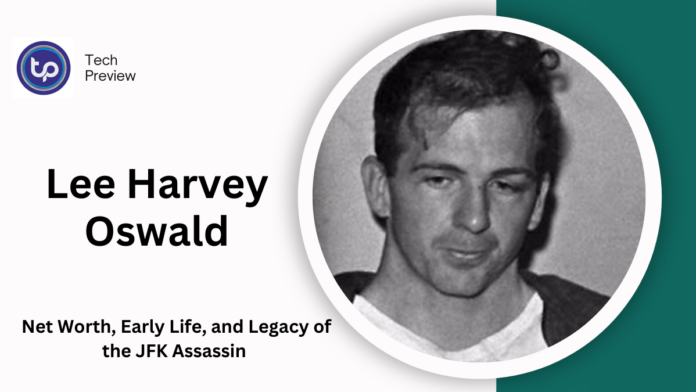Lee Harvey Oswald remains an infamous figure in American history, largely for his role in the assassination of President John F. Kennedy on November 22, 1963. His life, marked by conflict, confusion, and instability, was far from glamorous, and his financial situation at the time of his death was modest at best.
Oswald’s net worth, which stood at a mere $250, reflects a life that was more defined by turmoil than success.
Despite his lack of wealth, Oswald’s actions left a lasting impact on the United States and the world, and his story continues to fuel debates and conspiracy theories surrounding the assassination of JFK.
Biography
| Full Name | Lee Harvey Oswald |
| Born | October 18, 1939, New Orleans, Louisiana |
| Parents | Robert Edward Lee Oswald Sr. (father), Marguerite Frances Claverie (mother) |
| Nationality | American |
| Profession | U.S. Marine, Assassination Figure, Political Extremist |
| Famous For | Assassination of President John F. Kennedy |
| Net Worth (At Death) | $250 |
| Date of Death | November 24, 1963 (Shot by Jack Ruby) |
The Early Years of Lee Harvey Oswald
Born in New Orleans on October 18, 1939, Oswald’s early life was far from ordinary. His father, Robert Edward Lee Oswald Sr., passed away before he was born, leaving his mother, Marguerite Frances Claverie, to raise him.
Marguerite moved to Dallas, Texas, where Oswald attended a total of 12 different schools throughout his childhood.
His constant shifting from one school to the next, coupled with a lack of emotional support from his mother, contributed to his troubled behavior and emotional difficulties.
Diagnosed with a personality disturbance, Oswald struggled with loneliness and a sense of alienation from an early age, traits that would shape much of his future.
Oswald’s educational journey was fragmented, and at age 17, he dropped out of high school. This decision marked the end of his formal education, but it was the beginning of his involvement in the U.S. military—a choice that would play a significant role in shaping his path.
MUST READ: Billy McFarland’s Net Worth: How a Failed Festival Left Him in Debt
Oswald’s Time in the U.S. Marines
Oswald enlisted in the U.S. Marine Corps in 1956, just a week after his 17th birthday. His time in the military was turbulent. Although he was trained as a radar operator, Oswald faced disciplinary issues that led to a reduction in rank and even brief imprisonment after a physical altercation with a superior officer.
However, his interest in foreign languages grew, and while still serving, Oswald taught himself Russian—a skill that would later play a critical role in his defection to the Soviet Union.
Despite his problems with the military, Oswald’s time in the Marines offered him a unique vantage point of the world.
His exposure to different cultures and ideologies, particularly his growing fascination with communist thought, eventually led him down a path of radicalization.
Defection to the Soviet Union
In 1959, after receiving a hardship discharge from the Marine Corps, Oswald traveled to the Soviet Union, where he expressed his desire to renounce his U.S. citizenship and become a Soviet citizen.
Initially, Soviet officials were reluctant to accept him, but after injuring himself to prolong his stay, Oswald was allowed to remain in the USSR. He settled in Minsk, Belarus, where he worked at a factory that produced electronics.
Though he lived a relatively comfortable life by Soviet standards, Oswald grew dissatisfied with his life in the USSR.
In 1962, after just a few years in the Soviet Union, Oswald applied to return to the United States. His repatriation was approved, and he returned to America in mid-1962, marking the end of his short-lived Soviet experience.
A Life of Instability Upon Return to the U.S.
Upon returning to the U.S., Oswald struggled to find stability. He bounced from job to job, unable to settle into any career.
His radical political views became more pronounced, and he increasingly sought to express his dissatisfaction with American society. During this period, he attempted to assassinate retired U.S. General Edwin Walker, a prominent anti-communist figure.
Though the assassination attempt failed, it indicated the direction Oswald’s mind was headed: towards violence as a means of expressing his extreme political beliefs.
In the years leading up to the assassination of President Kennedy, Oswald’s life continued to spiral into chaos.
His marriage to Marina Prusakova, a Russian woman he had met while in the Soviet Union, was strained, and his growing alienation from society only fueled his sense of anger and resentment.
The Assassination of President John F. Kennedy
On November 22, 1963, Lee Harvey Oswald shot and killed President John F. Kennedy from the sixth floor of the Texas School Book Depository in Dallas.
As Kennedy’s motorcade passed through the city, Oswald took aim and fired, striking the president in the head and neck.
Shortly after, Oswald also shot and killed Dallas police officer J.D. Tippit, who had approached him on the street. Oswald was arrested soon after and charged with the murders of both Kennedy and Tippit.
During his arrest, Oswald maintained his innocence, claiming he was a “patsy.” However, his arrest and subsequent death by gunshot at the hands of Jack Ruby, a local nightclub owner, led to even more questions and speculation about the events surrounding Kennedy’s assassination.
The Warren Commission, formed to investigate the assassination, concluded that Oswald had acted alone, though many conspiracy theories continue to challenge this official account.
The Aftermath and Legacy
Following his death, Lee Harvey Oswald’s remains were buried in Rose Hill Cemetery in Fort Worth, Texas. His grave would become a point of interest and controversy for many years, with rumors circulating that a Russian look-alike had been buried in his place.
In the late 1970s, his body was exhumed, and dental records confirmed that it was indeed Oswald.
The coffin that had held his remains was later sold at auction for nearly $88,000 in 2010, although Oswald’s brother successfully sued to recover it, highlighting the continued fascination with Oswald’s legacy.
Though Oswald’s financial situation at the time of his death was extremely modest, his actions would have far-reaching consequences for the nation.
His assassination of President Kennedy remains a pivotal moment in U.S. history, sparking a range of political, social, and cultural discussions that continue to this day.
Conclusion
Lee Harvey Oswald’s life, from his humble beginnings to his role in one of the most significant events of the 20th century, remains one of the most complex and debated subjects in modern history.
His modest net worth of $250 reflects a life of instability, with little financial success to his name.
However, his infamy is not tied to his wealth but rather to his actions—the assassination of President John F. Kennedy, an event that shaped the course of American history.
While the official investigation concluded that Oswald acted alone, the mystery surrounding his motives and possible conspiracies continues to intrigue people around the world.
People May Ask
1. What was Lee Harvey Oswald’s net worth at the time of his death?
Oswald’s net worth at the time of his death was just $250, reflecting his lack of financial stability and the chaotic nature of his life.
2. Did Oswald have a stable career before the assassination?
No, Oswald struggled to maintain steady employment after returning to the U.S. from the Soviet Union. He frequently changed jobs and had difficulty settling into a routine.
3. What led to Oswald’s defection to the Soviet Union?
Oswald’s fascination with communism and his dissatisfaction with American society led him to defect to the Soviet Union in 1959, where he briefly lived and worked before returning to the U.S. in 1962.
4. Did Oswald act alone in the assassination of President Kennedy?
The official investigation by the Warren Commission concluded that Oswald acted alone, although many conspiracy theories suggest that others may have been involved.
Click here to learn more.









